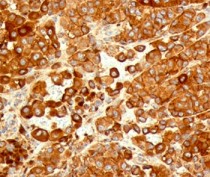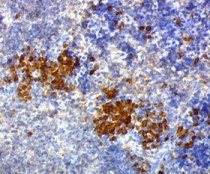ARG55941
anti-CD63 antibody [NKI/C3]
anti-CD63 antibody [NKI/C3] for Flow cytometry,ICC/IF,IHC-Formalin-fixed paraffin-embedded sections and Human,Mouse

Overview
| Product Description | Mouse Monoclonal antibody [NKI/C3] recognizes CD63 |
|---|---|
| Tested Reactivity | Hu, Ms |
| Tested Application | FACS, ICC/IF, IHC-P |
| Host | Mouse |
| Clonality | Monoclonal |
| Clone | NKI/C3 |
| Isotype | IgG1, kappa |
| Target Name | CD63 |
| Antigen Species | Human |
| Immunogen | Smooth plasma membrane fraction of MeWo cells. |
| Conjugation | Un-conjugated |
| Alternate Names | Tspan-30; CD63 antigen; Tetraspanin-30; CD antigen CD63; Lysosomal-associated membrane protein 3; OMA81H; Ocular melanoma-associated antigen; Granulophysin; TSPAN30; Melanoma-associated antigen ME491; MLA1; LAMP-3; ME491 |
Application Instructions
| Application Suggestion |
|
||||||||
|---|---|---|---|---|---|---|---|---|---|
| Application Note | IHC-P: Antigen Retrieval: Boil tissue section in 10 mM Citrate buffer (pH 6.0) for 10-20 min, followed by cooling at RT for 20 min. * The dilutions indicate recommended starting dilutions and the optimal dilutions or concentrations should be determined by the scientist. |
Properties
| Form | Liquid |
|---|---|
| Purification | Purification with Protein G. |
| Buffer | PBS (pH 7.4), 0.05% Sodium azide and 0.1 mg/ml BSA |
| Preservative | 0.05% Sodium azide |
| Stabilizer | 0.1 mg/ml BSA |
| Concentration | 0.2 mg/ml |
| Storage Instruction | For continuous use, store undiluted antibody at 2-8°C for up to a week. For long-term storage, aliquot and store at -20°C or below. Storage in frost free freezers is not recommended. Avoid repeated freeze/thaw cycles. Suggest spin the vial prior to opening. The antibody solution should be gently mixed before use. |
| Note | For laboratory research only, not for drug, diagnostic or other use. |
Bioinformation
| Database Links | |
|---|---|
| Gene Symbol | CD63 |
| Gene Full Name | CD63 molecule |
| Background | The protein encoded by this gene is a member of the transmembrane 4 superfamily, also known as the tetraspanin family. Most of these members are cell-surface proteins that are characterized by the presence of four hydrophobic domains. The proteins mediate signal transduction events that play a role in the regulation of cell development, activation, growth and motility. The encoded protein is a cell surface glycoprotein that is known to complex with integrins. It may function as a blood platelet activation marker. Deficiency of this protein is associated with Hermansky-Pudlak syndrome. Also this gene has been associated with tumor progression. Alternative splicing results in multiple transcript variants encoding different protein isoforms. [provided by RefSeq, Apr 2012] |
| Function | Functions as cell surface receptor for TIMP1 and plays a role in the activation of cellular signaling cascades. Plays a role in the activation of ITGB1 and integrin signaling, leading to the activation of AKT, FAK/PTK2 and MAP kinases. Promotes cell survival, reorganization of the actin cytoskeleton, cell adhesion, spreading and migration, via its role in the activation of AKT and FAK/PTK2. Plays a role in VEGFA signaling via its role in regulating the internalization of KDR/VEGFR2. Plays a role in intracellular vesicular transport processes, and is required for normal trafficking of the PMEL luminal domain that is essential for the development and maturation of melanocytes. Plays a role in the adhesion of leukocytes onto endothelial cells via its role in the regulation of SELP trafficking. May play a role in mast cell degranulation in response to Ms4a2/FceRI stimulation, but not in mast cell degranulation in response to other stimuli. [UniProt] |
| Cellular Localization | Cytoplasmic |
| Highlight | Related products: CD63 antibodies; Anti-Mouse IgG secondary antibodies; Related news: Tools for studying Exosomes |
| Calculated MW | 26 kDa |
| PTM | Palmitoylated at a low, basal level in unstimulated platelets. The level of palmitoylation increases when platelets are activated by thrombin (in vitro). |
Images (4) Click the Picture to Zoom In
-
ARG55941 anti-CD63 antibody [NKI/C3] ICC/IF image
Immunofluorescence: 100% Methanol fixed (RT, 10 min) HeLa cells stained with ARG55941 anti-CD63 antibody [NKI/C3] at 1:200 dilution. Left: primary antibody (green). Right: primary antibody and DAPI (Merge).
Secondary antibody: ARG55393 Goat anti-Mouse IgG (H+L) antibody (FITC)
-
ARG55941 anti-CD63 antibody [NKI/C3] FACS image
Flow Cytometry: MCF-7 cells stained with PE-conjugated ARG55941 anti-CD63 antibody [NKI/C3] (red); Cells alone (black); Isotype control (green).
-
ARG55941 anti-CD63 antibody [NKI/C3] IHC-P image
Immunohistochemistry: Human melanoma stained with ARG55941 anti-CD63 antibody [NKI/C3].
-
ARG55941 anti-CD63 antibody [NKI/C3] IHC-P image
Immunohistochemistry: Mouse spleen stained with ARG55941 anti-CD63 antibody [NKI/C3].
Customer's Feedback
 Excellent
Excellent
Review for anti-CD63 antibody [NKI/C3]
Application:IF/ICC
Sample:HeLa
Fixation Buffer:100% Methanol
Fixation Time:10 min
Fixation Temperature:RT ºC
Permeabilization Buffer:0.1% Triton X-100
Primary Antibody Dilution Factor:1:200
Primary Antibody Incubation Time:overnight
Primary Antibody Incubation Temperature:4 ºC
Conjugation of Secondary Antibody:FITC













